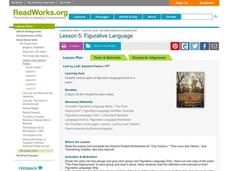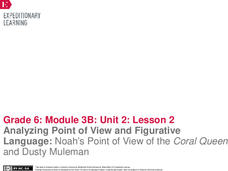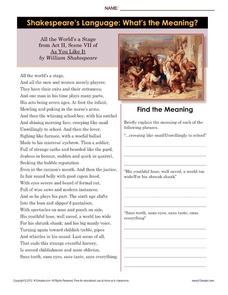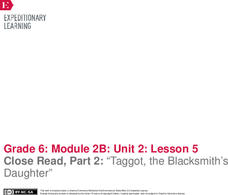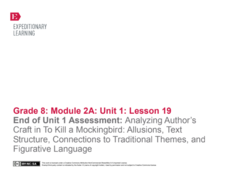Curated OER
Fall Similes
Fall is like a beautiful painting come to life—or is it more like an overflowing cornucopia? Practice writing similes with a lesson on figurative language. As learners review simile structure, they come up with their favorite similes for...
Curated OER
Figurative Language
Students interpret figurative language. In this language lesson, students are read the poem "I Love the Look of Words" by Maya Angelou and are to find examples of hyperbole and personification in the poem. Students then rotate among...
Curated OER
Exploring Figurative Language in Fiction and Nonfiction
A reading of Pat Street's There's a Frog in My Throat launches a study of figurative language. Using a pocket chart, display one phrase containing figurative language. Class members choose the best explanation from three choices offered....
Curated OER
Identifying Figurative Language #1
In this identifying types of figurative language worksheet, students read sentences and phrases, determine if they are similes, metaphors, hyperboles, personifications, or a combination, identify the type/s and write an explanation of...
Curated OER
Language Play
Introduce your scholars to onomatopoeia and alliteration using a language elements worksheet. They examine six sound words and match them to four pictures. Next, learners read two examples of alliteration and write one of their own. They...
Poetry Society
How do Poets Use Language?
Why do writers choose the language they do? Here's a resource that has the poet himself answer that very question. Joseph Coelho explains why he chose the words and images he used in his poem, "If All the World Were Paper."
Roald Dahl
Matilda - Miss Honey and The Trunchbull
As the instructor reads aloud several quotes from five chapters of the story Matilda, class members mime their interpretation of the scenes. Then, after reading "Miss Honey" and "The Trenchbull" (chapters seven and eight), the class...
EngageNY
Grade 10 ELA Module 4: Unit 2, Lesson 18
Macbeth describes life as a light and a candle, suggesting it is fleeting and meaningless. Using the resource, scholars engage in an evidence-based discussion and complete a Quick Write about Shakespeare's use of figurative language in...
Read Works
Figurative Language
Do your learners need to practice identifying figurative language? This lesson plan outlines a method for working on that tricky skill. After teacher modeling and think-aloud, fourth and fifth graders identify examples of figurative...
EngageNY
Analyzing Point of View and Figurative Language: Noah’s Point of View of the Coral Queen and Dusty Muleman
Literally, what's the meaning? Scholars read pages seven through nine of Flush and discuss literal and nonliteral meaning with figurative language. Learners work in triads to identify and define unfamiliar words. They then complete a...
E Reading Worksheets
Figurative Language Finder
To demonstrate their understanding of figurative language, middle schoolers use a guided reading worksheet to find examples of figurative language in a text, identify the technique being used, and to explain how they were able to...
K12 Reader
Working with Figurative Language
Are your middle schoolers able to identify the literary devices featured on this activity? They must demonstrate their understanding of figurative language by matching the terms with their definitions and label the devices used in short...
Curated OER
Figurative Language
Fifth graders identify and categorize figurative language in poetry.They read a poem and find an example of figurative language, then read the included hand-out on figurative language, and describe each type of figurative language. They...
August House
Anansi and the Pot of Beans
Anansi is a tricky character, but can he realize he's wrong and write an apology letter? Learners use Anansi and the Pot of Beans to practice writing, art, and figurative language. A series of activities are engaging for both advanced...
K12 Reader
Shakespeare's Language: What's the Meaning?
You needn't be an actor to stage this exercise in reading comprehension. Kids examine Jacques's "All the World's a Stage" speech from Act II, scene ii, of As You Like It, and explain the literal meaning of the figurative language. There...
Curated OER
Go Free or Die
Groups of older elementary learners begin their study of figurative language by visiting a website and completing the exercises detailed there. They then apply what they have learned by finding examples in several poems. Finally, they...
EngageNY
Contrasting Two Settings (Chapter 6: "Lost Melones/Cantalouples")
Continue working through Esperanza Rising, by Pam Munoz Ryan, by looking into language choices and discussing text-dependent questions. Pupils converse in small groups and as a class about plot, setting, and figurative language. Using...
Curated OER
I Have A Dream - Pastel Drawings
Discuss the meaning of Martin Luther King Jr.'s "I Have A Dream" speech, explore figurative language, and read about Harriet Tubman and her courage. After the discussion, learners analyze painter/author Jacob Lawrence's use of...
EngageNY
Close Read, Part 2: “Taggot, the Blacksmith’s Daughter”
It is just a figure of speech. Readers look for figurative language as they read Taggot, the Blacksmith’s Daughter. They complete a Figurative Language graphic organizer by recording and identifying the types of figurative language found...
K12 Reader
Proverbs and Adages Match
The grass may be greener on the other side, but a activity about proverbs and adages is sure to help readers of all levels master figurative language. Kids match the idioms in the first column to their literal meanings in the second...
K12 Reader
Animal Proverbs and Adages
What will play when the cat's away? Practice figurative language with a list of proverbs about animals. Kids use the word bank at the top of the page to fill in the blanks based on their knowledge of common phrases.
EngageNY
Understanding Douglass’s Words: An Escape Attempt
Make a match! Scholars play a matching game after looking at excerpt five from Narrative of the Life of Frederick
Douglass. Learners match types of figurative language with example sentences, and add to their powerful language word wall...
EngageNY
End of Unit 1 Assessment: Analyzing Author’s Craft in To Kill a Mockingbird: Allusions, Text Structure, Connections to Traditional Themes, and Figurative Language
Scholars demonstrate their learning with an end-of-unit assessment. They work independently to discuss the Golden Rule and its relationship in To Kill a Mockingbird.
MENSA Education & Research Foundation
Magical Musical Tour: Using Lyrics to Teach Literary Elements
Language arts learners don't need a lecture about poetry; they listen to poetry every day on the radio! Apply skills from literary analysis to famous songs and beautiful lyrics with a lesson plan about literary devices. As class...
Other popular searches
- Figurative Language Poetry
- Figurative Language in Poems
- Figurative Language Quiz
- Figurative Language Project
- Imagery Figurative Language
- Figurative Language Lessons
- Using Figurative Language
- Figurative Language Worksheets
- Figurative Language Test
- Figurative Language in Poetry
- Figurative Language Vocabulary
- Figurative Language in Prose










